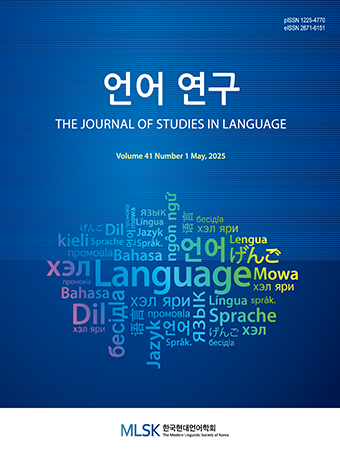Research Article
Abstract
References
Information
This study investigates the nominal syntax of three article-less languages—Japanese, Korean, and Turkish—challenging the assumption of uniformity among so-called “NP-languages.” While these languages lack overt articles, they diverge significantly in their structural configurations, particularly concerning the presence or absence of a dedicated Case Projection (KP) above the NP. Drawing on insights from Bošković (2008, 2012, 2014), Despić (2011), and Takahashi (2011), I argue that Japanese consistently projects a KP, Turkish entirely lacks KP, and Korean occupies a transitional position: it employs Turkish-like NP structures with bare numerals but adopts Japanese-like KP projections when numerals combine with classifiers. Evidence for these distinctions comes from word order, binding phenomena, and partial ellipsis tests, including possessor-stranding NP-ellipsis. This analysis reveals that NP-languages are far more heterogeneous than previously recognized. Korean’s dual nominal configurations offer critical insights into cross-linguistic variation and morphological triggers, broadening our understanding of generative typology and the syntax of article-less languages.
- Abney, S. P. 1987. The English Noun Phrase in its Sentential Aspect. Ph.D. dissertation, Massachusetts Institute of Technology.
- Ahn, S.-H. 1990. Korean Quantification and Universal Grammar. Ph.D. dissertation, University of Connecticut.
- Bošković, Ž. 2008. What will you have, DP or NP?. In E. Elfner and M. Walkow (eds.), NELS 37: Proceedings of the Thirty-Seventh Annual Meeting of the North East Linguistic Society. Amherst, MA: GLSA, 101-114.
- Bošković, Ž. 2012. On NPs and Clauses. In M. Richards and A. L. Malchukov (eds.), Distributive Syntax: Locality in the Interfaces. Oxford: Oxford University Press, 33-63.
- Bošković, Ž. 2014. Now I’m a Phase, Now I’m Not a Phase: On the Variability of Phases with Extraction and Ellipsis. Linguistic Inquiry 45.1, 27-89. 10.1162/LING_a_00148
- Bošković, Ž. and Şener, S. 2014. The Turkish NP. In Crosslinguistic studies on noun phrase structure and reference. Brill, 102-140. 10.1163/9789004261440_006
- Chae, H.-S. 1983. On the Syntax of Numerals and Classifiers in Korean. Korean Linguistics 2, 45-68.
- Chierchia, G. 1998. Reference to Kinds across Languages. Natural Language Semantics 6.4, 339-405. 10.1023/A:1008324218506
- Despić, M. 2011. Syntax in the Absence of Determiners. Ph.D. dissertation, University of Connecticut.
- Hale, K. and Bittner, M. 1996. Structural Case and the Nature of the Agreement. In J. Rooryck and L. Zaring (eds.), The View from Building 20: Essays in Linguistics in Honor of Sylvain Bromberger. Cambridge, MA: MIT Press, 29-67.
- Kayne, R. 1994. The Antisymmetry of Syntax. Cambridge, MA: MIT Press.
- Kitagawa, Y. and Ross, C. 1982. Prenominal Modification in Japanese and the Structure of the NP. Linguistic Analysis 9.1, 19-53.
- Longobardi, G. 1994. Reference and Proper Names: A Theory of N-Movement in Syntax and Logical Form. Linguistic Inquiry 25.4, 609-665.
- Saito, M., Lin, T.-H., and Murasugi, K. 2008. N’-Ellipsis and the Structure of Noun Phrases in Chinese and Japanese. Journal of East Asian Linguistics 17.4, 247-271. 10.1007/s10831-008-9026-8
- Takahashi, D. 2011. Case, Phases, and N’-Ellipsis in Japanese. Journal of East Asian Linguistics 20.4, 297-328.
- Publisher :The Modern Linguistic Society of Korea
- Publisher(Ko) :한국현대언어학회
- Journal Title :The Journal of Studies in Language
- Journal Title(Ko) :언어연구
- Volume : 40
- No :4
- Pages :511-525
- DOI :https://doi.org/10.18627/jslg.40.4.202502.511




 The Journal of Studies in Language
The Journal of Studies in Language






